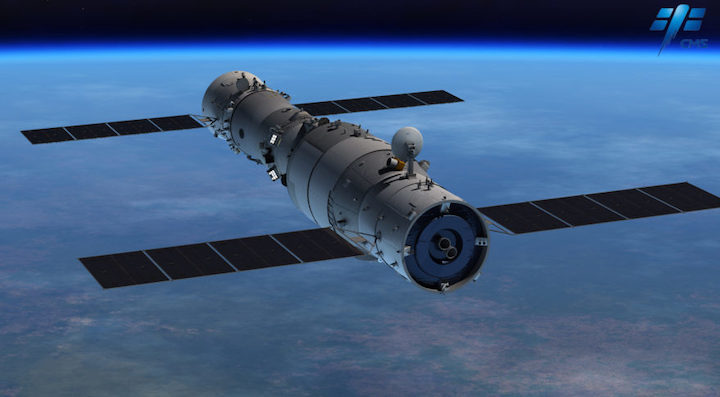HELSINKI — China appears set to deorbit its Tiangong-2 space lab in the near future, according to a social media release from the China Manned Space Engineering Office (CMSEO).
CMSEO announced a quiz competition (Chinese) Friday through its WeChat social media platform account, testing knowledge of launch times and mission details, to mark the ‘return of Tiangong-2’. No date for the planned re-entry was stated by CMSEO, which manages China’s human spaceflight endeavors.
Following the loss of contact with Tiangong-1 and subsequent uncontrolled re-entry of the 8.2-metric-ton spacecraft in April 2018, China announced in September last year that Tiangong-2 would be deliberately deorbited in 2019.
Lin Xiqiang, deputy director of the China Manned Space Engineering Office (CMSEO), stated that the space lab was functioning normally and would continue experiments and Earth observation until deorbiting in or after July 2019.
A SpaceNews query earlier this month to the United Nations Office for Outer Space Affairs, which receives advance information on high interest re-entries such as Mir and Tiangong-1, revealed that no updates had been received regarding the status of Tiangong-2.
SpaceNews first reported last year that a lowering of the spacecraft’s orbit indicated a probable deorbiting of the spacecraft.
Tiangong-2 shortly after raised from this lower orbit of 292 by 297 kilometers altitude back to its standard mission orbit and is currently in a 378 by 387 kilometers orbit.
When it deorbits Tiangong-2 will use its own propulsion systems to reenter the Earth’s atmosphere, likely over the South Pacific Ocean Uninhabited Area, and will mostly burn up in the process. The spacecraft had successfully completed its engineering and science objectives in 2017 following refueling tests with the Tianzhou-1 cargo craft.
Also in July Longjiang-2 (DSLWP-B), a 47-kilogram microsatellite launched in May 2018 along with the Queqiao relay satellite for the Chang’e-4 lunar far side mission, will impact the moon following a maneuver to bring this mission to a safe end. Earlier this month the spacecraft returned an image of the total solar eclipse over the Pacific using a small ‘Inory Eye’ camera.
From Tiangong to modular space station
Tiangong-2 was launched in September 2016 to test advanced life support and refueling and resupply capabilities via the crewed Shenzhou-11 and uncrewed Tianzhou-1 cargo missions, in preparation for constructing a large, modular space station in low Earth orbit.
The 10.4-meter-long spacecraft hosted two astronauts, Jing Haipeng and Chen Dong, for the vast majority of the 33-day Shenzhou-11 mission, which remains China’s longest human spaceflight mission.
Tiangong-2 is a more advanced version of the Tiangong-1 space lab launched in 2011. Both were designed as steppingstones for developing and verifying technologies for larger 20-metric-ton modules for the planned Chinese Space Station (CSS), a long-term ambition laid out in 1992.
China planned to launch the ‘Tianhe’ core module of the CSS in 2018, but the launch failure of second Long March 5 rocket in July 2017 has led to postponement of the test launch of the Long March 5B, a variant designed for carrying the space station modules into low Earth orbit.
An official with the China Aerospace Science and Technology Corporation, the country’s main space contractor, told state-run Xinhua News Agency in January that a mission dress rehearsal involving a non-flight model of the rocket and the CSS core module would be carried out at Wenchang at the end of 2019. This would be part of preparations for the test flight of the Long March 5B which, if successful, would lead to the launch of the first CSS module in 2020.
However the requisite return-to-flight of the Long March 5 — then slated for mid-July — appears to have slipped, with no indication from China as to when the launch will take place. The delay also means that the Chang’e-5 lunar sample return mission will almost certainly not take place in late 2019 as planned.
According to plans released by China, the 60-100-metric-ton Chinese Space Station will consist of a core module and two experiment modules. It is expected to be completed by ‘around 2022’ and will be capable of hosting three astronauts for long durations and up to six during crew turnover. It will be joined by a co-orbiting Hubble-class space telescope that can dock for propellant supply, maintenance and repairs.
In June six experiments were selected for a place aboard the future Chinese Space Station through a joint international cooperation initiative, with three more receiving conditional acceptance.
Quelle: SN

